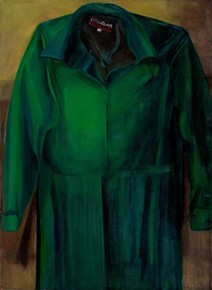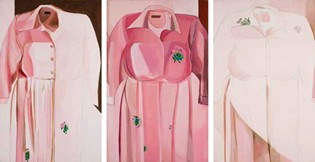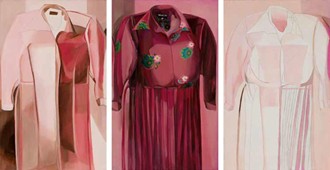
Serife 2, Image courtesy of Salt / the artist.

Serife 6-7-8, Image courtesy of Salt / the artist.

Serife 9-10-11, Image courtesy of Salt / the artist.
Identity, Art and Freedom of Artistic Creativity: Şerife
Part 1
Turgut Tarhanlı, Manifold Press, May 16, 2024
Translation: Çağla Özbek
This article is the transcript of Prof. Turgut Tarhanlı’s talk delivered at Salt Galata on 26 March 2024, as part of the publication “İpek Duben: The Skin, Body, and I,” which was held at Salt Galata with contributions by Esen Karol and Çağla Özbek. The event can be watched on Salt’s YouTube channel.
Unlike the two other speakers present for this discussion today, I did not contribute in any way to the preparation of the book titled The Skin, Body, and I,1 which was published by Salt. However, I delivered an online talk in the context of İpek Duben’s retrospective exhibition carrying the same title which held at Salt Beyoğlu two years ago, delving into artistic freedom in Turkey and İpek Duben’s oeuvre. I can say that both my close friendship with İpek and her husband Alan, and the fact that I have been following and reading her work from the 1980s onwards played an important part in my accepting the invitation to take part in this event. However, I am neither an art historian nor an art critic.
I would like to emphasize that my approach in beginning this speech on the topic of “law” is not based on an overarching preference to operate within the playing field drawn by the rules of law. I believe the main axis of my speech will attest to this.
In the year 2009, a new position of Special Rapporteur was established within the United Nations Human Rights Council: “Special Rapporteur in the Field of Cultural Rights”,2 and Farida Shaheed, the Pakistani sociologist and feminist activist, was appointed as its founder. Shaheed spearheaded the preparation of this research, which was shaped by field research and the responses and contributions of states and NGOs to the rapporteur’s questionnaire. The research was finalised in 2013 and shared in a report which was thematically entitled “The right to freedom of artistic expression and creativity”.3
The report in question is particularly significant concerning an interpretation [of creativity] within the contexts of art, politics and the law, as it identifies and clarifies the components of said interpretation; as a contribution, it strengthens the perspective of human rights on this subject. Farida Shaheed’s report is also valuable in the way it clearly elucidates the components of artistic expression and the ways in which artistic freedom can be perceived parallel to but differently from freedom of expression, especially with regards to the common approach where artistic freedom is generally and categorically evaluated and confined within the realm of freedom of expression. The formal character of artistic expression, as outlined in the framework presented in the report, is significant in the way it is not limited to mere freedom of expression evaluated in the context of human rights and the manner in which it illustrates a conceptual expansion that adds to its value.
An artwork differs from non-fictional statements, as it provides a far wider scope for assigning multiple meanings: assumptions about the message carried by an artwork are therefore extremely difficult to prove, and interpretations given to an artwork do not necessarily coincide with the author’s intended meaning. Artistic expressions and creations do not always carry, and should not be reduced to carrying, a specific message or information. In addition, the resort to fiction and the imaginary must be understood and respected as a crucial element of the freedom indispensable for creative activities and artistic expressions.4
It could be argued that the views expounded upon in this report lack a certain intellectual depth in terms of art theory or art criticism. While such an assessment may hold some validity, it cannot be disregarded that the report aims to create international standards regarding freedom within the realm of human rights law. The significant aspect of this report is that it presents a conception of rights that is not limited to freedom of expression in its strictest and broadest sense, but one that transcends it, attempting to articulate this by underscoring notions of “fictionality” and “the imaginary” within the bounds of artistic freedom.
In my view, the title of Farida Shaheed’s report, “The Right to Freedom of Artistic Expression and Creativity,” was chosen precisely because it attempts to re-delineate the conceptual framework of this field of rights based on this specific parameter. The report attempts to describe and explore the structural characteristics of a field of rights composed of “artistic expression” and “artistic creativity.” It materializes and gains meaning through the inclusion of the “creativity” component within the realm of human rights law, which is the aspect most worthy of attention. Understandably, this subject naturally transcends the bounds of human rights and the law, requiring an interdisciplinary perspective and understanding.
***
Today, I would like to touch upon a few works of Duben in particular and delve into the “creativity” component of the right to artistic expression and freedom of creativity. This endeavour does not involve a legal case study focused on freedoms or the interpretation of a practice in terms of norms, but it can be suitably described as an attempt at an interdisciplinary reading on freedom of artistic expression.5
When observing Duben’s works, I find it important to see the “critical dimension” that makes “visible what the dominant consensus tends to obscure and obliterate, in giving a voice to all those who are silenced within the framework of the existing hegemony”, to quote political theorist Chantal Mouffe.6 However, this is not an ex negativo act, nor is it about adopting a critical position for the sake of being critical in any situation.7
It is ironic that the period when Duben produced and first exhibited her series of paintings titled Şerife (in April 1982), which could be considered an initial turning point in her artistic career, coincided with a time when Turkey, amidst the atmosphere of the 12 September military coup d’état, was struggling to define the constitutional framework that also included artistic freedoms. What is particularly ironic is that as the controlled political elite circles advocated a notion of “the objectivity of art” at the state level, both addressing and imposing it during constitutional negotiations under the guise of designating an entire nation’s legal geometry,8 the subjectivity constructed by Duben’s artistic propositions in the Şerife series voiced a conceptual force that reached far beyond said debate and time period. Perhaps it was not clearly articulated as an open and sided hegemonic struggle, but it was not at all a naive attempt that ignored socio-political domination, either.
In an interview that Duben had with Vasıf Kortun, included in the publication that is the subject of our discussion today, the artist states the following:
For people who lead primarily unselfconscious lives, time’s meaning and significance differ. In 1977–78 this was the Istanbul of low income, uneducated migrants from villages living on the city’s outskirts. I had two missions: To paint people I was trying to understand and get to know the contemporary art scene.9
Within the framework it was depicted [as part of the work], the image of Şerife materializes in the dresses ascribed to her at the expense of her body; said image includes a manifold of multilayered facets, including the experience of being a woman, being a woman who emigrated from her hometown, as well as being a domestic worker. Observing the artistic and formal choices made by the artist, it seems natural that this series as a whole can be defined as a signifier of the artist’s freedom. As I touched upon a moment ago, the mere fact that the name Şerife is uttered and comes to define this series is significant within a societal network of interpersonal dynamics, whereby women who take on paid domestic work are obscured and obliterated by the dominant consensus,10 not even being referred to by their first name but only addressed as “the woman”. This gesture is a clear refusal to identify with the dominant hegemonic discourse, but it is also evident that the series is centered around an “absence”. In the same interview included in the publication, Duben says the following on these works:
Fifteen months later, I had made eleven headless Şerifes, and the twelfth was of the dress on a hanger. None of the shapeless-looking bag-like dresses revealed her physical presence. Her absence was her signature; the dress was a metaphor for the average lower-class Turkish woman and came to represent all women denied their rightful place in society. Şerife painting exhibition (State Fine Arts Gallery, Istanbul, 1982) was my first solo show.11
The meaning constructed with the series Şerife reaches beyond the gesture of refusing to identify with the dominant hegemonic discourse, though, and constitutes the true focal point of the freedom of artistic creativity. This is an image of “empty space”, dependent on Şerife’s absence as a person. This artistic preference may be considered unorthodox for the period it was exhibited, and indeed, it really was.12
Duben’s attitude of refusal by creating an “empty space” or purposeful “caesura” gains meaning as the focal point of a struggle to create a novel way of identification. In another interview years prior, Duben had described this situation as follows: “There was a woman’s body in these paintings, but no personality.”13
The space in question that was left empty by the artist does not only comprise the invisibility of a woman who has a name but no materiality. While this situation was critically caused by Şerife’s preference [to not sit as a model for the artist] in real life, it may also very well constitute a reflection of a certain state of invisibility that is both dominant in gender relations and rendered visible in the realm of gender. The act of noticing, reminding and rendering visible this “empty space” (which, notably, is not “absence”) not only constitutes a novel way of identification, but also an expression of a subjectivity constructed through artistic expression and freedom of creativity. The series is also an uncovering of a conflict enveloped by social and personal realities which was concealed, made invisible, through hegemonic political relations; it also harbours in its quest for meaning an invitation to the viewer to grasp the empty space in question, directing them to reflect on and reckon with this conflict.14
The series Şerife incorporates one other focus that I would like to note. In reference to the social sciences literature of its time, we can also view these works as an early articulation of “intersectionality”, especially considering that Kimberle Crenshaw’s watershed essay on this subject was published in Chicago Law Forum in 1989.15 The fundamental notion that justifies this evaluation is the fact that İpek Duben not only titled her series of paintings after Şerife—a decision underpinned by a humane approach that I commend—but also transposed, in many ways, the identifying characteristics of this real woman in terms of her social, economic, cultural, and political aspects.
Presently, Duben advocates the following view on the tension between traditional values and women’s identity in the interview included in the publication which is being presented to the public through this event:
The significance of “ahlak” [morality] and “namus” [honor] concerning women in Turkey was an important issue to tackle … So I felt bound to address the contentious ground in the context of my initial question, “Who am I?”
In Traces and Manuscript 1994, I use my body as a vessel where tradition and modernity would meet and break as I look at the past and the present. The body stands naked with arms up and hands chopped off without gravitational force holding it; bodies are floating, suspended in space. By way of material appearance of nudity in the paintings, I propose purity, interiority, and transparency as codes of morality and honor. I am asserting my existential stance.16
Undoubtedly, the nude body photographs in question, depicting Duben’s own body in four different ways and used repeatedly in various forms across her works, signify her protest against traditional value judgments. This gesture mirrors a political and aesthetic stance that appears to be in stark opposition to the traditional template of women’s identity, as articulated by Pierre Bourdieu in his significant work, Masculine Domination. This is how Bourdieu explains it: “female submissiveness seems to find a natural translation in bending, stooping, lowering oneself, ‘submitting’ — curved and supple postures and the associated docility being seen as appropriate to women.”17
As such, this question of identity which was voiced by Duben as “Who am I?” is not a pushing of the boundaries of what can be thought.18 As Charles Taylor stresses, “My identity is defined by the commitments and identifications which provide the frame or horizon within which I can try to determine from case to case what is good, or valuable, or what ought to be done, or what I endorse or oppose. In other words, it is the horizon within which I am capable of taking a stand.”19 Illustrating a mindset that spans both Turkey and the United States, İpek Duben explicates her views on this matter as follows:
I became fully aware of the significance of identity in all walks of life, especially in art and culture. My acute awareness of this stereotyping must have been essential to my interest in identity issues.20
However, it is evident from the interview in the book that the artist does not interpret the issue of identity within a static framework limited solely to her personal universe. Instead, she critically examines her own history and imbues this issue with a broader and more critical significance:
It was, therefore, a natural progression for me to move from dealing singularly with my own identity as a woman from certain social strata to a more inclusive group of all kinds of women for whom male violence was part of their lives with fathers, brothers, husbands, and even older sons. Şerife’s identity as a nameless and headless woman was personified by her absence inside her dress.21
Through these words, Duben sincerely conveys the transformation in her thoughts, while Şerife, a creation of her own, emerges as an “autonomous entity” from within the artist’s narrative, reflecting a blend of personal and social developments and confrontations. This imagery eloquently captures the artist’s connection to her own work, the excitement she harbors for its value, and the dynamism of her artistic orientation articulated through a discourse that emphasizes the animation of a fictional character within a context whereby both social issues and sensitivity are emphasized without sacrificing social criticism.
NOTES
- İpek Duben: The Skin, Body and I, ed. Vasıf Kortun (Istanbul: Mousse Publishing & Salt, 2024), p. 272 (Henceforth referred to as The Skin, Body and I). ↩
- Special Rapporteur in the field of cultural rights. Special Rapporteurs also undertake country visits on issues within their mandate. The Special Rapporteur on cultural rights made such an offer to Turkey in 2012, which was not accepted, and again in 2017, as a reminder. However, such a visit has not yet taken place. See “Country Visits”, UN. ↩
- Farida Shaheed, “The right to freedom of artistic expression and creativity”, Report of the Special Rapporteur in the field of cultural rights, 14 March 2013. ↩
- Shaheed, Report of the Special Rapporteur…, p. 9. According to a view cited in the Special Rapporteur’s report, artists should have the freedom to explore the darker side of humanity and express it without facing criminalization. Ibid. ↩
- On the contextuality of signification, see Chantal Mouffe, Agonistics: Thinking the World Politically (London: Verso, 2013) p. 196. ↩
- Mouffe, Agonistics: Thinking The World Politically (London: Verso, 2013) p. 183. ↩
- Boris Groys, Art Power (The MIT Press, 2008), 17. ↩
- See Turgut Tarhanlı, “Sanatsal İfade ve Yaratıcılık Özgürlüğü Hakkı Bağlamında Şiddet, Hafıza ve Sanat” in Hafıza ve Sanat Konuşmaları 2020, ed. Eylem Ertürk and Sevim Sancaktar (Istanbul: Truth Justice Memory Center, 2021), 39–43. ↩
- The Skin, Body and I, 20. ↩
- Mouffe, Agonistics: Thinking The World Politically, 112. ↩
- The Skin, Body and I, 28. ↩
- Sezer Tansuğ, “Mübarek Giysi Takımı”, Gösteri, June 1982; see also İpek Duben: Interviews and Reviews (Istanbul: Akbank Sanat, 2009), 7. ↩
- Lale Filoğlu, “İpek Aksüğür Duben: ‘Bu Sergi Bir Albümün Açık Hâli Olarak Algılanabilir’,” Vizyon, 52 (Nov. 1994); see İpek Duben: Interviews and Reviews, 25. ↩
- Mouffe, Agonistics: Thinking The World Politically, 116. ↩
- Kimberlé Crenshaw, “Demarginalizing the Intersection of Race and Sex…,” University of Chicago Legal Forum 1989, no. 1 (1989): 139. ↩
- The Skin, Body and I, 32. ↩
- Pierre Bourdieu, Masculine Domination, trans. Richard Nice (Stanford: Stanford UP, 2001), 27. ↩
- See James M. Jasper, Protest: A Cultural Introduction to Social Movements (Polity Press, 2014), 112. ↩
- Charles Taylor, Sources of the Self: The Making of the Modern Identity (Cambridge: Harvard UP, 1992), 27. ↩
- The Skin, Body and I, 42. ↩
- The Skin, Body and I, 53. ↩